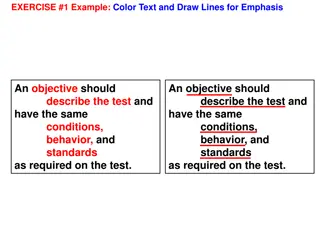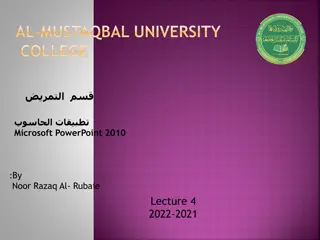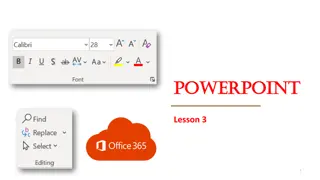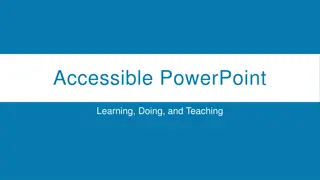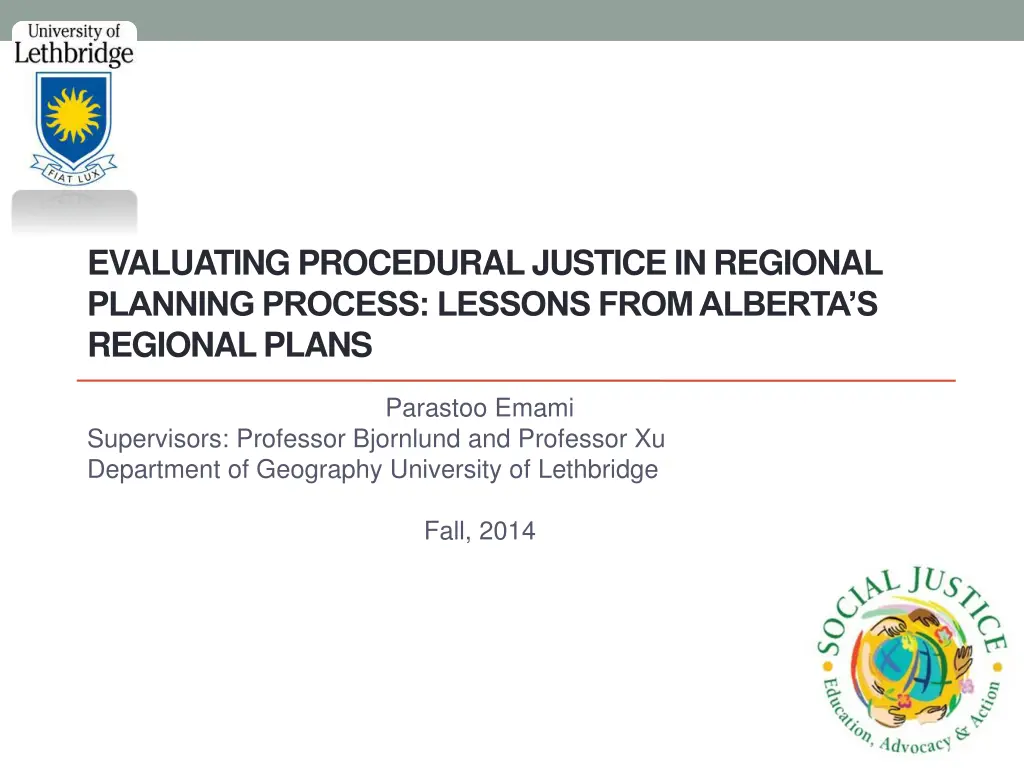
Evaluating Procedural Justice in Regional Planning: Lessons and Challenges
Explore the significance of procedural justice in regional planning, focusing on water management challenges in Alberta. Uncover the impact of fairness on resource allocation, transparency, public acceptance, and legitimacy of water plans.
Download Presentation

Please find below an Image/Link to download the presentation.
The content on the website is provided AS IS for your information and personal use only. It may not be sold, licensed, or shared on other websites without obtaining consent from the author. If you encounter any issues during the download, it is possible that the publisher has removed the file from their server.
You are allowed to download the files provided on this website for personal or commercial use, subject to the condition that they are used lawfully. All files are the property of their respective owners.
The content on the website is provided AS IS for your information and personal use only. It may not be sold, licensed, or shared on other websites without obtaining consent from the author.
E N D
Presentation Transcript
EVALUATING PROCEDURAL JUSTICE IN REGIONAL PLANNING PROCESS: LESSONS FROM ALBERTA S REGIONAL PLANS Parastoo Emami Supervisors: Professor Bjornlund and Professor Xu Department of Geography University of Lethbridge Fall, 2014
Index Introduction Background Literature Methodology Findings: Procedural justice components Procedural justice models Conclusion Contributions Limitation
Introduction Water planning and management challenges: Climate change Increasing demands Various users (urban, agriculture, industrial) Governments and the society have become more sensitive A fair water management and plans Fairness is a multifaceted concept. Procedural justice is one of the main pillars fair allocation of resources, adds transparency to the process, improves public acceptance and legitimacy of water plans Syme, et al., 1999, Stern, 2010, Trobst, et al., 1990, Caraddock, et al., 1999, Bjornlund, 2010
Background Water management real challenge in Alberta Laws, regulations, and policies: Riparian Doctrine (1870) --- Water Act (2000) Water for Life Alberta s strategy for Sustainability (2003) Alberta drought (2010) In 2008, new environmental management approach was adopted Integrated Resource Management (IRM) Cumulative Effect Management System (CEMS) Alberta flood (2013) Toronto Sun, 2013, Environment news service, 2010, Bjornlund, 2010, Bjornlund and Klein, in press
Background New management approach: Land-Use Framework (2008) (LUF) Alberta Land Stewardship Act (2009) ALSA (2009) divides Alberta Seven regions Lower Athabasca South Saskatchewan Region s characteristics / challenges Oil sand industry development Intense population growth Alberta Environment, 2008, 2009, 2010
Background Regional plans Legal documents Broad strategic plans Subject to regular reviews RP administration: Land use Secretariat Regional Advisory Council In case of conflict RP prevail over all water, land, and air legislations. RP challenges: Ambiguity and unclearness relationships and responsibilities Alberta Environment, 2010, Lavelle, 2012, de Lo , 2009
Research objectives The broad goal: social justice in water management and planning Research objectives: 1. Develop a theoretical framework 2. Evaluate procedural justice in Alberta regional plans 3. Identify critical components of procedural justice Research questions: How did the public and stakeholders in Alberta perceive the fairness of the regional planning process? 1. What are the critical components of procedural justice in Alberta s regional planning process? 2.
Literature review The tensions and challenges the way water is viewed and manages change The effect of social, economic, and environmental forces in the hydro-political process: Integrated Water Resource Management (IWRM): Manages water and land maximizes economic and social welfare in an equitable manner encourage multiple actors/agents decision making process Challenges IWRM: complex issue of decision making and integrating various sectors rise probability conflict and injustices in water allocation Allan, 2005, GWP-TAC4, 2000, Saravanan, et al., 2009, Bogardi, 1994
Literature review Issues of justice : resources are not equally distributed between groups, or resources are (or are perceived to be) in short supply Various perspectives School of thoughts Social justice: a fair and equal society in which each individual matters, their rights are recognized and protected when decisions are made Egalitarianism Economic Theories of justice justice Social Justice Theories of Liberalism Social Utilitarianism Environmental Procedural Justice Distributive Justice Equity Wenz,1988, Nozick,1974, Rawl, 1999, Patrick, 2012, Clayton, 2000, Lundy, 2011, Hamowy, 2004
Literature review Procedural justice: examines each step of the decision-making process and evaluates whether it is just Active Participation Resolving Conflict Legitimate Representative Unbiased Framework Informative Procedure Unbiased selection of agents Accuracy of information Providing Knowledge Identifying shared value Voice There are three main theories: 1. Theory of procedure(Thibaut and Walker, 1975) = resolve conflict 2. Justice judgment theory (Leventhal, 1980) = procedural justice components 3. Group value model (Lind and Tyler, 1988) = procedural justice in decision making Preparing public for effective participation Right to participant Control on process Consistency Fair decisions Equal Control on making final decisions Develop a theoretical framework 4. Procedural fairness for civil dispute resolution (Solum, 2004) 5. Social justice in water management (Syme and Nancarrow, 2001) Ease of operation Providing compensation opportunity to participant Minimizing bias Correctability Solum, 2004, Lukasiewicz et al., 2013, Syme et al., 2001, 2005, Thibaut and Walker, 1975
Methodology Procedural justice: moral and philosophical aspect of human psychology. Many scholars uses qualitative method to conduct the research Data collection: four sources Government documents Law, regulation, and policies Regional planning documents Total 98 documents In-depth interviews Local /Provincial Government Regional Advisory Council Stakeholder Total 16 participants Public documents Blog Posts Websites Total 100 documents Observations Stakeholders meeting Public meeting Water conversation Total 30 hours Rigor and confidentiality Lawrence, et al.,1997, Lukasiewicz et al., 2013, Syme et al., 2001, 2005
Methodology Data analysis: Two methods: Thematic analysis and content analysis Nvivo Content Analysis Thematic Analysis Use a word query Code in NVivo (paragraph or sentences) Create a codes from the result of the word Query Create a hierarchy structure Create a hierarchy structure Creating the themes Creating the themes Comparing themes with the key words and criteria from literature Comparing themes with the key words and criteria from literature Weber, 1990, Liamputtong, 2009, Krippendorf, 1980, Stemler, 2001
Methodology In-depth interview participants: 3 2 LARP( 6) person SSRP(10) 1 0 RAC Government WPAC/ irrigation First nations Planners Data saturation (SSRP) Data saturation (LARP) 100% 100% 90% 90% 90% 90% 80% 75% 80% 70% 70% 70% Interview #1 60% 60% Interview #1 55% 60% 60% Interview #2 50% Interview #2 50% 50% interview #3 40% interview #3 40% 40% Interview #4 30% Interview #4 30% interview #5 20% 20% 10% 10% 0% 0% Code Coverage Code Coverage
Procedural justice components Identified procedural justice components: categorized three groups Designing a fair process Designing a fair process Procedural rules Clear vision and objectives Public engagement process process Unbiased representation Public engagement Effective public participation strategies Voice Decision making process process Decision-making authorities and responsibilities Decision making Understanding conflicts and gaps Understanding implementation challenges
Procedural justice components The results reveal that: the way that the process is designed effects the fairness A fair planning process 1. follows procedural rules 2. has clear visions and objectives Consistency in the planning process Cumulative Effect Management System (CEMS) Transparency in the planning process Integrated Resource Management (IRM) Clear visions and Procedural rules objectives Using accurate information Clarification of the current regional visions and objectives Comprehensible and easy to follow Clarification of the current definition public participation Ethicality and consultation
Procedural justice components The results also show that: The consultation process needs to be improved Unbiased representation Public engagement strategies Effective public participation 1) 2) 3) Advertising public participation opportunities Value the public input Unbiased selection of Regional Advisory council (RAC) Using effective public engagement tools Bilateral Communication Public engagement Effective public Unbiased representation strategy participation Clarifying RAC s responsibilities Using focus group to manage public participation I do not know that for sure [if you can get any response back] (KI#16)
Procedural justice components To improve the decision making process: 1. Decision making authorities and responsibilities 2. Gaps and conflicts 3. Implementation challenges Understanding the value conflicts and gaps Lower Athabasca Region Land Use Secretariat and Cabinet Implementation Decision making authorities and responsibilities Gap and conflicts challenges Designing an appealing mechanism and South Saskatchewan Region Limiting lobbying and political decisions providing compensations (correctability) In SSRP, the plan s outcomes are so high level [and general] WPAC are not working with LARP. LARP has own team (KI#16) implementing them will challenging (KI#2)
Procedural justice model Decision making process Plan design Public consultation process Theme7 Theme 8 Theme 1 Theme6 Theme4 Theme5 Theme 2 Theme3 Clarifying role of Land use Secretariat and Cabinet Unbiased selection of RAC Advertising public participation opportunities Consistency Value of the public input LARP Understanding the value conflicts and gaps CEMS Transparency SSRP IRM Bilateral communi -cation Clarifying RAC s responsibilities Using effective public engagement tools Accuracy Clear vision and objectives Limiting lobbying and making political decisions Correctability Easy to understand Clear definition of public participation Minimizing bias Using focus group to manage public participation
Conclusion - implementation There are many opportunities to improve procedural justice in Alberta regional plans There are five up coming plans The procedural justice model: simplifies the planning process highlights additional steps to ensure a fair planning process enhances the acceptance of regional plans
Conclusion - contribution This research also 1. adds weight to one side of the debate in the literature 2. verifies the critical components identified in the reviewed literature. unbiased framework, informative procedure, legitimate representative, active participation, and resolving conflicts 3. identifies differences between the literature and the conceptual findings clear of vision and objectives, understanding gaps, and implementation challenges
Conclusion - reflection Limitation Time Access to various representatives Social, cultural differences Future studies Evaluate the fairness of five upcoming plans Evaluate the fairness of the plans outcome Evaluate the fairness of similar regional plans
Thank you Parastoo.emami@uleth.ca
References [1] Jonathan A Allan. Water in the environment/socio-economic development discourse: Sustainability, changing management paradigms and policy responses in a global system. Government and Opposition, 40(2):181 199, 2005. [2] Paula Antunes, Giorgos Kallis, Nuno Videira, and Rui Santos. Participation and evaluation for sustainable river basin governance. Ecological Economics, 68(4):931 939, 2009. [3] Robert Bewer. Recreational ecosystem service benefits from the Chestermere lake reservoir: value for day use non- resident vision. University of Lethbridge, 2012. [4] Henning Bjornlund. The competition for water: Striking a balance among social, environmental, and economic needs. CD Howe Institute, 2010. [5] Bjornlund, H.; Nicol, L. and Klein, K. (in press): The Adoption of Improved Irrigation Technology and Management Practices - A Study of Two Irrigation Districts in Alberta, Canada. Accepted for publication in the Journal of Agricultural Water Management [6] Randall W Block and Joel Forrest. Gathering storm: Water conflict in Alberta, a. Alta. L. Rev., 43:31, 2005. [7] Ian Calder. Blue revolution: Integrated land and water resources management. Routledge, 2012. [8] J.C. Caldwell and Loyola University Chicago. Critical Factors in Social Justice Orientation Development. Loyola University Chicago, 2008. [9] Christine Carpenter and Melinda Suto. Qualitative research for occupational and physical therapists: A practical guide. Blackwell Pub., 2008.
References [10] Madonna G Constantine, Sally M Hage, Mai M Kindaichi, and Rhonda M Bryant. Social justice and multicultural issues: Implications for the practice and training of counselors and counseling psychologists. Journal of Counseling & Development, 85(1):24 29, 2007. [11] Alberta Water Council. Alberta s water management system: Policy issues and gaps. 2006. [12] Ian Craddock, Alan William Preece, Rajagopal Dept NILAVALAN, Jack Albert Leendertz, Ralph Benjamin, Frederick John9 Sprats Barn Crescent Wilson, et al. Methods and apparatus for measuring the internal structure of an object, December 5 2012. EP Patent 1,850,743. [13] John W. Creswell. Research Design: Qualitative, Quantitative, and Mixed Methods Approaches. SAGE Publications, 2009. [14] RC de Lo . A Canadian vision and strategy for water in the 21st century. Policy Options, 30(7), 2009. [15] Robert C De Lo . From Government to Governance: A State-of-the-art Review of Environmental Governance: Final Report. Rob de Lo Consulting Services, 2009. [16] Neil M Drew, Brian J Bishop, and Geoff Syme. Justice and local community change: Towards a substantive theory of justice. Journal of Community Psychology, 30(6):623 634, 2002. [17] Alberta Environment. Cold lake-beaver river basin groundwater quantity and brackish water state of the basin report. 2006. [18] Alberta Environment. Water for renewal. 2008. [19] Alberta Environment. Water for life action plan. 2009.

















